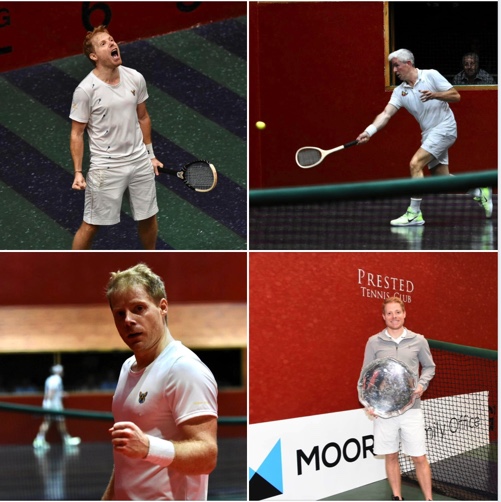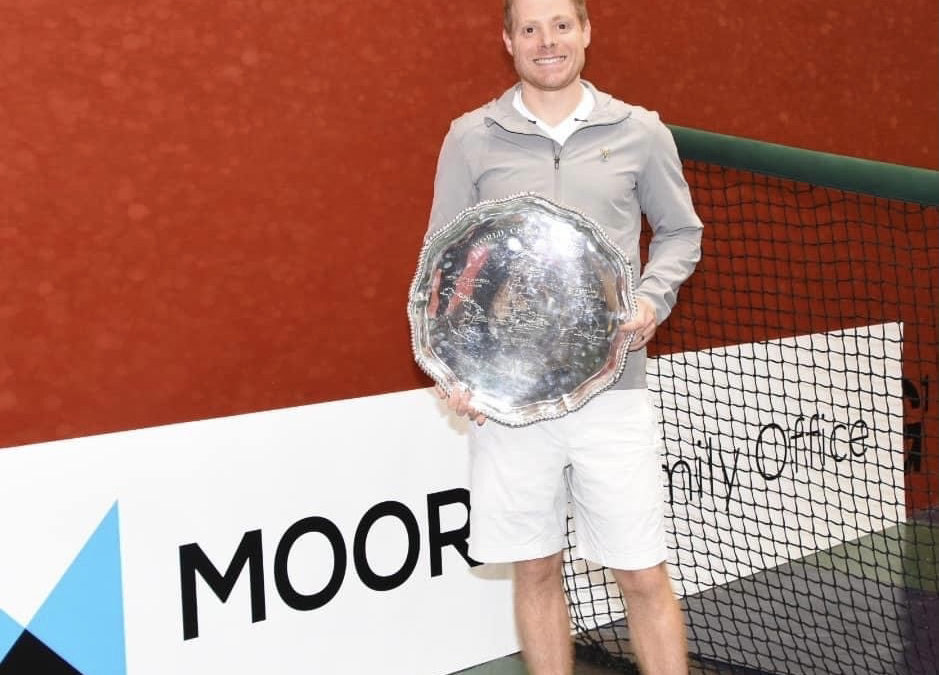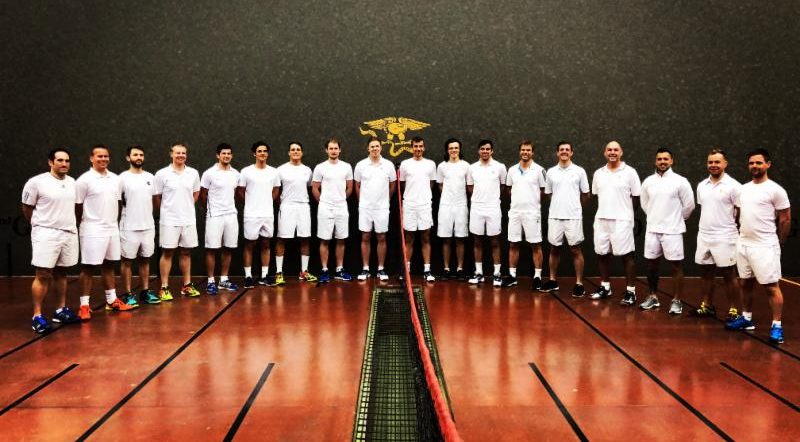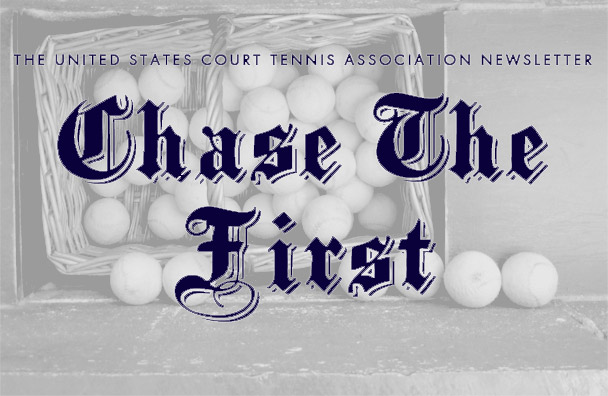by James Zug
Third Day
6-3, 3-6, 5-6, 6-2
FINAL Riviere 5-6, 6-3, 4-6, 6-2, 6-2, 6-2, 6-3, 5-6, 6-3, 3-6, 5-6, 6-2
It was an even colder, damper Thursday afternoon at Prested for Day Three, upper fifties and raining. Everyone, though, was happy to gather again, needing to return to the scene after having barely recovered from Day Two. Ringing in everyone’s ears—still echoing out through the car park and down Prested’s long drive and into Feering—was the roar after the climatic final point of Day Two.
It was a twenty-six stroke masterpiece at 5-all, 40-30, set-point for Rob Fahey. Camden Riviere was on hazard size. He smacked one ball of the tambour and as he had all day slaloming across the court to get every other ball. Looking thirty years younger himself, Fahey flashed from side to side like greased lightning. Once he desperately dug out a ball under last gallery and then spun off the wall, a youthful 360, and recovered back to the middle of the court. It was breathtaking. Three times Fahey nearly slid the ball into winning gallery. The rally ended with Riviere punching the ball into the net and Fahey raising his arms like a prizefighter after a knockout.
No one conceived that the Day Three could be better. Fahey was down 5-3 in sets. He had the momentum from the last set. But his feet were hobbled. He changed sneakers on Day Two and afterwards there were three reports on what was happening—“My feet are broken,” was what Fahey said; “He’s fifty-four,” said his wife, women’s world champion Claire Fahey; and later we heard about swelling of the interphalangeal joints of his toes and a toenail coming off. This is the beauty and pain of the Challenge—three days of concentrated play that takes its toll.
The courtside punters and pundits said that Fahey would have to win the ninth set—the first of Day Three—if he would be able to make any sort of substantive inroads on Riviere. That proved not to be true. Fahey lost the ninth set. He evened it at 1-1 and then it was 5-1 for Riviere. Fahey climbed back, saving five set points across a couple of games before Riviere buried a ball into the grille to clinch it 6-3.
Fahey varied his serve significantly for the first time in the Challenge—under-arm twists, demi-piques, a few chandelles. But Riviere stymied him. For decades with Fahey, he had a steady, clear-cut pattern of short, decisive points. When serving, it was serve, return, ball into the grille; and when receiving it was serve, main-wall force. Bang.
At Prested, his serves weren’t that intimidating, according to Giles Doy’s Winning Gallery feed. Usually a server wins about sixty percent of the points played; in the Challenge, Riviere was winning fifty percent but Fahey only thirty-six percent, with a further thirty percent of the points ending with Riviere setting a chase.
And on Day Three Fahey’s return wasn’t troubling Riviere enough at the start. In the tenth set, Riviere started off with two grilles in the first game, but quickly momentum swung towards Fahey. He secured his first two-game lead since the middle of the third set on Day One when he was briefly up 5-3—in other words, since forever. He got breathing room at 3-1, then 4-2, then 5-3. Then he closed out the set.
Confident and focused, Riviere kept plugging away. Their pre-return routines deepened: Fahey blowing on his hand, tugging on the shorts on the left leg; Riviere tugging on his shirt, lifting it up.
The eleventh set reminded everyone of the eighth set. Riviere hopped to a lead—3-1 and then 5-3—and then Fahey reeled it back. Fahey tried to force on every ball he could. Riviere started to miss slightly—three times at 5-4 he clipped the top of the net, twice the ball went down and the third time it went over. At 5-all, the tension was unbearable. Riviere had two championship points and couldn’t convert either. In one rally, he had balls off the back wall and even the penthouse, almost sitters, and neither time he was unable carve them out of Fahey’s reach. On the second of Fahey’s set points, the champion converted.
A twelfth set. Extraordinary. The first couple of games were very tight. But Riviere didn’t deflate after being within a point of victory. Showing real intestinal fortitude, he backed it up, remaining calm, exhibiting strong body language, continuing to play his game. At the same time, Fahey noticeably slowed, making racquet errors, grimacing every time he put a ball up on the penthouse (once even momentarily shifting his racquet to his left hand as he made his way back into position to await Riviere’s reply).
Then it was 5-2, 40-30 and Riviere serving and defending a chase of a yard worse than last (what at Prested, with its large striped floor, is called chase BFG or Big Fat Green). Finally, the ball went Riviere’s way and victory was finally his.
For Riviere, he became just the third man to win a world singles championship, lose it and then come back to reclaim it again (after Peter Latham in 1907 and Fred Covey in 1922). It was an emotional moment for all Americans. It was a mere week after the funeral of another American world champion, Pete Bostwick, and it was just a few hours after another American tennis legend, Sam Howe, had died at the age of eighty-four. Two Hall of Famers passing from the scene, and Riviere, with his stirring victory, breathed new life into U.S. tennis.
And then there was Fahey. Afterwards, he said simply: “I was very glad to put on a spectacle worthy of this event.” He had done that, winning five sets, pushing it deep into a third day, remaining on court for well over eight hours and forcing his challenger to play his absolute best.
During the middle of Day Three’s play, another tennis GOAT with the initials RF came out to announce his retirement from competition. Roger Federer was a counterpart to Rob Fahey—both played with crowd-pleasing style and punishing panache; both had complete games, with no weaknesses and far too many strengths; both set the career mark for Grand Slam victories (Federer’s mark is now broken of course); and both stayed at the top of the game far past the age when everyone else retired.
It is all but certain that Fahey will not attempt to join the Eliminators and return to the Challenge when it is next held in 2023. So we have seen the last time he plays at the very highest level. Thirteen times he won the world title. Will that record ever be broken?
And Fahey came within a whisker of topping the only legitimate accolade he left unclaimed. Pierre Etchebaster reigned as world champion for 321 months (from May 1928 to February 1955), the longest stretch in which actual championships were regularly played. Fahey ends his reign just two months short at 319 months (March 1994 to May 2016 and April 2018 to September 2022).
Just as Great Britain this week said farewell to one beloved ruler and welcomed another, real tennis did the same. Long live the king.
Follow the links below to read James Zug’s stories for Days One and Two:
World Championship – Day Two
World Championship – Day One
PHOTOS BY TIM EDWARDS




